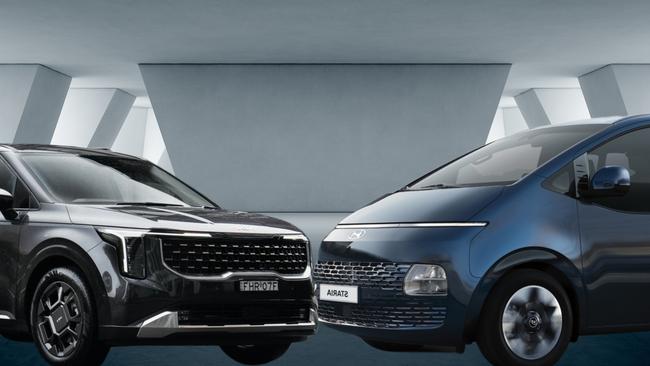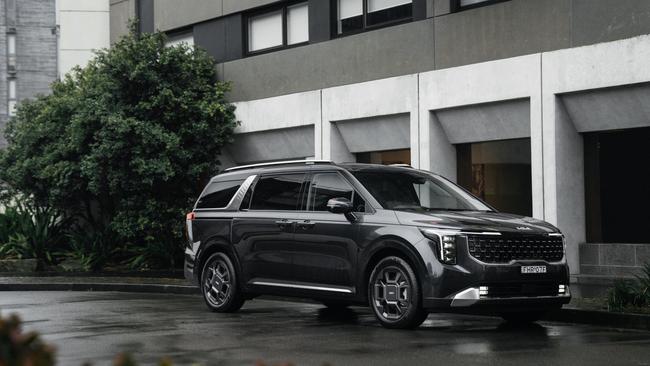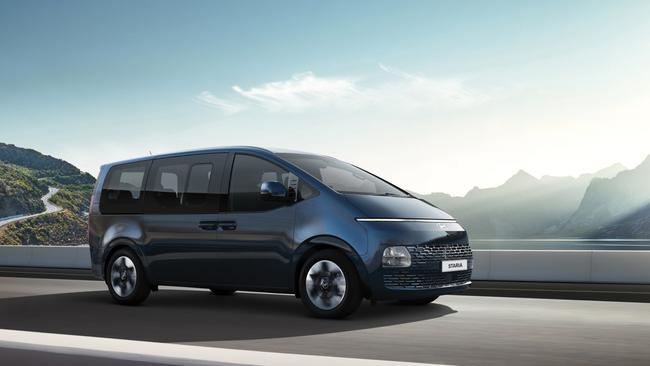Who comes out on top in the battle of the mini-vans?
Between the Kia Carnival and Hyundai Staria there can only be one winner – and by ‘winner’ I mean one which I hated significantly less than I expected to.

I’d like you to summon to mind the moment of movie magic when Catherine O’Hara realises she’s lost her beloved boy Kevin again, in Home Alone 2, and screams operatically into the camera.
Personally, I always equate that squeal of horror with the one any parent would make when they realise they’ve made the mistake of having five children (Kevin had two brothers and two sisters) and must thus buy a people mover.
Being a hugely scientific road tester, I’ve always shunned offers to borrow these big buses, because – thanks to the magic of vasectomies – I just don’t have the offspring to fill them.
Over the holidays, however, my overly generous wife decided to invite her entire extended family to live in our home for two weeks, which meant I had to source not one but two eight-seater vans, which allows me to write one of those pieces beloved of serious car mags: the comparison test. In this case, between Hyundai’s huge Staria ship (I felt the need to sing We Built This City – often voted the worst song of all time – while driving it) and Kia’s Carnival.
The first thing I used the Carnival for was as a place to hide while my better half spent 19 consecutive hours cleaning our house to the point where it looked like no one had ever lived in it, pretty much a minimum standard for when one visitor arrives, but now multiplied by eight. I chose the Carnival to cower in because it is simply nicer than the Hyundai in every conceivable way, which might help explain why it has been the best-selling people mover in our post Baby Bonus country for 20 of the past 21 years.

When it came time for one of my 312 trips to the airport and back, however, I would often reach for the Staria’s keys because while it is more tractor-like to drive, and shaped more like a Greyhound bus (albeit one with a sci-fi front end design that brings to mind Robocop’s head) it is undeniably more capacious, particularly in the boot (the Hyundai holds 831 litres back there, the Carnival a still impressive 627 litres).
Piloting the hulking Hyundai with its tractor-like 2.2-litre turbo-diesel (130kW and 430Nm) filled me with the kind of enraged ennui that I know would dominate my life if I was an actual bus driver. It’s quite likely I would be sacked for biting ungrateful passengers, in fact – something I largely managed not to do during my many hours working as a Sydney tour guide for the in-laws.
The remarkable thing about the Carnival is that it is actually built on the same platform as the Staria (Kia and Hyundai are sister companies) and yet it feels entirely more car-like and damn near pleasant to drive. Indeed, my wondrous wife came to “love” piloting the Carnival, almost never bashed it into things despite its size, and didn’t want to give it back, until I suggested we could only justify keeping it if we had several more children of our own (the bilious look this produced on her face definitely had more to do with her husband than her beloved and beautiful offspring).
One of my brother in-laws – he’s a jazz musician, which unfortunately means I’m allergic to him and come out in hives if he gets too close – was also forced to steer the Kia at one stage, and after initially being intimidated by its size he got out raving about how easy it was.
Even more impressively, thanks to its clever HEV hybrid set-up (which means it starts up with the sound of silence rather than the bronchial coughs of the diesel Hyundai), combining a 1.6-litre petrol engine with a 54kW/304Nm electric motor, the fuel gauge barely moved over 350km of heavy hauling. I saw a figure of eight litres per 100km in that time – higher than the claimed 5.8l/100km economy number, but still impressive.

The combined outputs of 180kW and 366Nm might be lower than the V6 petrol model you can also choose for your Carnival, but this HEV never felt as asthmatic as the Hyundai and if you pressed its slightly absurd Sport button, which seems like putting running shoes on a hippo, it even made noises like it was really trying to be enthusiastic.
If I had to sum up my feelings for the Kia in one sentence, I’d say that I hated it significantly less than I expected to, and if Angelina Jolie does finally lob into my life, with all of her children, it is one of the many cars I will buy.
This brings us neatly to price. The Carnival I had was the most impressive GT Line, with a sticker of $76,210, which is a lot, but you can have a more proletarian one from $50,150, which is a bargain, while the Hyundai Staria ranges from $49,500 to $67,500.
I am declaring the Carnival the winner of my inaugural (and probably final) comparison test, unless you really have a lot of luggage, in which case you’ll need the Hyundai. What no one should need, ever, is both of them parked outside their house at once.
Kia Carnival GT-Line Hybrid
Engine: 1.6-litre four-cylinder plus electric motor (180kW/366Nm)
Transmission: 6-speed automatic front-wheel drive
Price: $76,210
Rating: 4.5/5
Hyundai Staria Highlander
Engine: 2.2-litre four-cylinder diesel (130kW/430Nm)
Transmission: 8-speed automatic, all-wheel drive
Price: $67,500
Rating: 3.5/5



To join the conversation, please log in. Don't have an account? Register
Join the conversation, you are commenting as Logout